Causes of condensation
The appearance of small drops on the walls and ceiling of the cellar is explained simply: they form on surfaces whose temperature is lower than the air temperature in the room. The air humidity is quite high and the basement can become damp both in winter and in summer.
Condensation accumulates on the floor and walls if the room above the cellar is heated, making the air temperature in it higher. But even if the basement above is empty, drops cannot be avoided: the ceiling will be covered with them because its surface is colder than the air inside.
What is the threat of constant dampness? First of all, the appearance of mold: fungus is harmful to both humans and the building. Over time, it destroys concrete and wooden floors, walls, floors, and also spoils the products stored in the cellar.
Condensation occurs when:
- There is no ventilation or it does not work properly.
- The basement is poorly insulated.
- High groundwater level and errors in the construction of the drainage system.
- There are cracks in the foundation of the house.
- No waterproofing on the walls and floor.
- Communication systems are leaking.
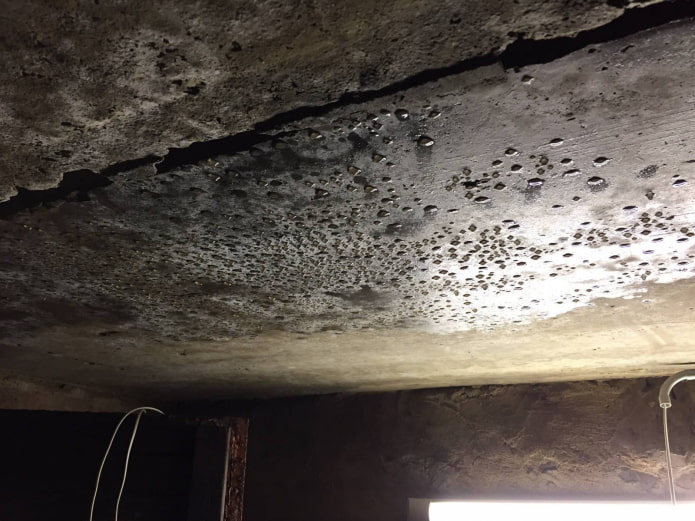
How do you know if the humidity level is high?
You can’t store food in a damp cellar: vegetables without airtight packaging quickly rot. In addition to the obvious signs of high humidity – condensation on surfaces, puddles on the floor, an unpleasant musty smell, darkening of the ceilings due to mold – there are other ways to determine this indicator.
The easiest way is to use a special device, a hygrometer. In a concrete basement, the optimal humidity should be like in a refrigerator – 85-95%.
If you do not have a hygrometer, you can resort to folk methods:
- Go down to the cellar with a lit candle. The flame in a dry room will move, and a crimson halo will appear around it. If the basement is humid, the flame will remain straight and motionless.
- Spread wood chips on vegetables, and after a day try to break them. In a dry basement, the chip will break with a crack, in a damp one – it will bend. A silently broken splinter will show the optimal humidity.
- Pour water into a glass bottle and put it in the refrigerator for a day. Move it to the basement. If the glass surface dries, the basement is dry. If condensation forms on it, the humidity is high. An indicator of the optimal microclimate is the absence of any changes on the bottle.
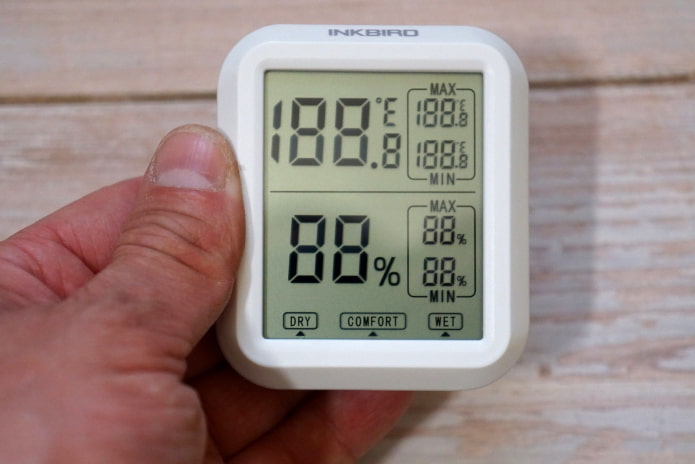
How to dry out a cellar?
To get rid of condensation, you need to carry out preparatory work and dry out the cellar. Do this on a sunny summer day. Clear the room of supplies, furniture (if any), boxes and shelves and treat wooden items against fungus. To do this, take them outside, wash them thoroughly with hot water and soap, and apply special products.
Wooden structures should be dried thoroughly, then coated with copper sulfate or any suitable product from the store: this way, condensation will not have a negative effect on them. Then you need to soak the wood with an antiseptic to protect it from rotting and destruction.
A special device, a dehumidifier, will help dry the room. Acting like a pump, it absorbs excess moisture and replaces it with warm, dry air. This eliminates condensation and creates an optimal microclimate in the cellar.
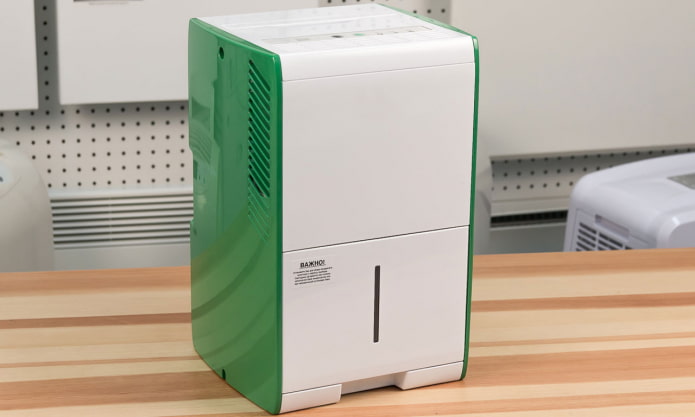
If you don’t have a dehumidifier, you can use a portable brazier, after airing the basement for a few days. It is important to light the brazier with the hatches and passages open so that the damp air can escape through the holes. The duration of the procedure depends on the area of the cellar and the amount of condensation.
Another method is a lit candle installed under the inlet of the exhaust pipe. It increases the air draft, gradually ridding the room of condensation and dampness. This budget option will take significantly more time than drying with a brazier. Also, experts advise using a household fan, but the effectiveness of this method has not been proven.
The best ways to combat the causes
The problem of condensation can be solved in several ways. This will allow you not to dry the cellar too often and eliminate the risk of mold.
Ventilation
If the cellar is separated from the upper floor by a wooden flooring, air renewal occurs naturally. If the floor is concrete, you cannot do without a ventilation system.
To do this, you need to buy two pipes with deflectors and make two holes with a hammer drill: one channel should be at a height of 100-150 mm from the floor in the basement, the other at the same distance ending under the ceiling.
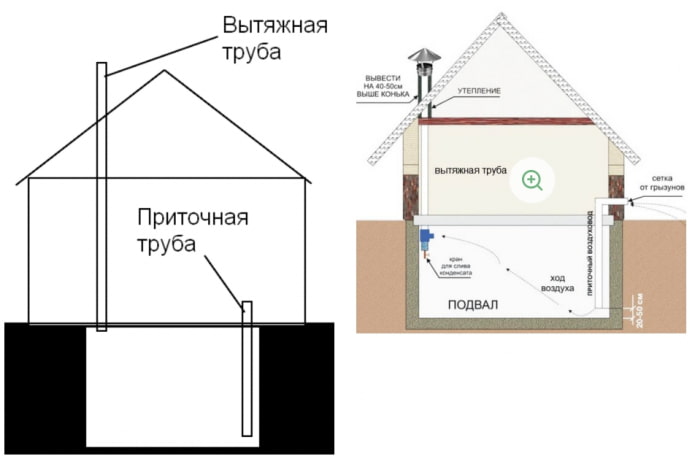
Air will enter through the pipe located below, and will be removed through the higher one. The operation of the natural system is highly reliable, does not require monitoring and electricity consumption. But the larger the area of the cellar, the larger the diameter of the air ducts required. A duct fan installed in the exhaust pipe will increase the air flow.
If the basement is small, it is enough to install one wind catcher pipe with supply and exhaust ducts for its ventilation. The flow intensity will be regulated by valves located above each of them.
Waterproofing
The installation of external waterproofing requires an investment of effort, money and time, since it is carried out in several stages. Ideally, this issue should be resolved at the time of construction. But the work can also be done outside the finished building:
- Dismantle the blind area.
- Dig a trench around the basement about a meter wide.
- Wait for the walls to dry and clean them of dirt.
- Treat with a deep penetration primer.
- Coat the foundation with bitumen, preferably in 2 layers.
- Fill the trench with soil and arrange the blind area.
Internal waterproofing should be done as follows:
- Dry the cellar.
- Remove whitewash, mold and dirt from the surfaces, including cracks and corners.
- Treat the walls, floor and ceiling with an antifungal agent.
- Coat the room with liquid waterproofing.
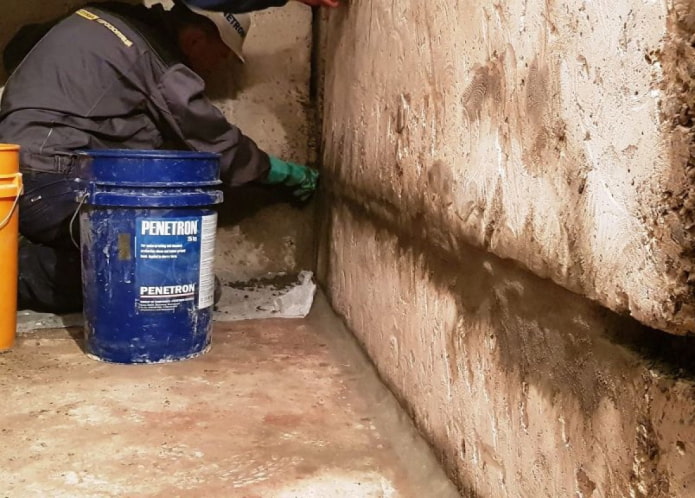
Thermal insulation
From the outside, the basements are insulated by spraying polyurethane foam. Thermal insulation is also carried out inside the basement: this method allows you to equalize the temperature of the walls and floor with the ceiling temperature and get rid of condensation. The following materials are used as insulation in the cellar:
- Dense foam plastic (C-25 and higher) or penoplex, which is used to cover the walls and ceiling. It is attached with plastic mushrooms and special glue.
- Wooden logs impregnated with an antiseptic composition and foam plastic, which are attached to the floor. A plank base is mounted on top.
- A mixture of sawdust and shavings with slaked lime. The ratio is approximately 1 to 10 (10 parts sawdust and one part slaked lime). Rodents do not like this loose insulation, but it lasts for many years.
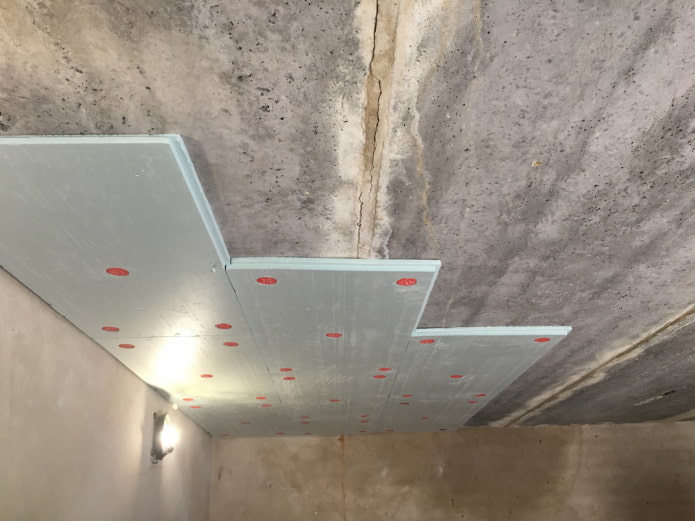
Prevention recommendations
To eliminate condensation drops that periodically appear in the basement, a single event or a whole range of measures may be required. Start with one thing, the simplest one.
If you ignore the recommendations and leave the cellar damp, moisture will not only spoil the utensils in the basement, but also harm your health. The most effective method of dealing with it is to install ventilation. This method not only helps remove condensation in the cellar, but also allows you to maintain a suitable microclimate in the room.
As a temporary measure, containers with absorbents will help: boxes or buckets with dry sand, sawdust, salt, quicklime. Place them around the cellar to absorb excess water. Also, do not forget to ventilate the basement in good weather so that the incoming dry air drives out the humid air.
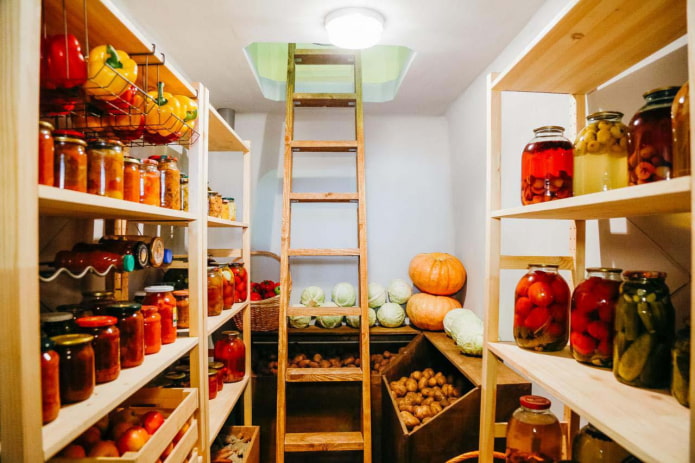
You can combine all of the listed methods to eliminate condensation in the basement forever. It is best to get rid of design flaws immediately – this will allow you to keep the premises in optimal condition without risking your health, home and seasonal supplies.
Now reading:
- Ceiling design: more than 90 photos and ideas for styles and spaces.
- Tips for Updating Your Kitchen on a Budget Without Renovating
- Shelves and bookcases: more than 60 photos, current design solutions
- Blue sofa: 84 examples in the interior and ideas for room design.
- Stylish Black and White Bathroom: Over 50 Photos and Design Ideas